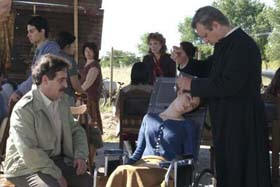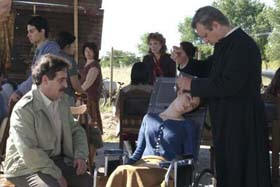
Doria, Eros and the Faun

Doria, Eros and the Faun
ROLANDO PÉREZ BETANCOURT
rolando.pb@granma.cip.cu
CubaNews
translation by Ana Portela. Edited by Walter Lippmann
http://www.granma.cubaweb.cu/2006/12/08/cultura/artic03.html
After fifteen years away from films, well known filmmaker Alejandro Doria (Esperando la carroza) with one of those movies that grabs “the great public”. Las Manos not only received the Best Director award at the last Huelva Festival but also the popularity award. It is interesting to note that the veteran Argentine filmmaker did not propose the project but was called to direct a form of biography on the father of Italian origin who healed with his hands.
THE HANDS OF ALEJANDRO DORIA
 And Doria did it as best he knew:
a solid script, resources of the most traditional melodramas of his country and
he knows how the wring hearts which pleases the audience and top quality acting
with the lead by Jorge Marrale who imbues life to the priest.
And Doria did it as best he knew:
a solid script, resources of the most traditional melodramas of his country and
he knows how the wring hearts which pleases the audience and top quality acting
with the lead by Jorge Marrale who imbues life to the priest.
This year, the film was a public success in Argentina and there was sufficient discourse about the controversial figure. A controversial treatise with the wisdom of someone who knows not to appear with a hagiographic tone, but comes out in favor of the powers of the good Mario.
The priest with a little orthodox spirit had to battle the high authorities of the Catholic Church, the government and police, a triad which did not enhance his popularity. And it is in the treatment of these relations, in the diverse dramatic means employed, where the director best demonstrates his wisdom and also the effects used by an old strategist of entertainment.
The Yara theater is overflowing to view Eros but the film was far from being what many thought. The legendary Antonioni, not a nonagenarian, the well-known Wong Kar Wai and the no less magnificent Steven Soderberg, intent on offering three versions where eroticism, sensuality and love are intermixed. One must be grateful that Michelangelo Antonioni was willing to take on one of his old subjects although now without complexity nor the mysteries of the past in dealing with the conflicts of a young couple where the lack of desire to go to bed has made them lose the magic of love.
Soderbergh follows the road of “intelectualizing” his subject but, in search of originality, begins substituting eros with psychoanalysis in a story with comic scenes not well rounded-out and located in the New York of the 50s. The best of the three whizzes —in spite of the wordiness of the argument —is Wong who uses a beautiful and mature Gong Li to narrate the story of a tailor who falls in love with a top courtesan and makes her clothing which in other, less sublime hands, will unrobe. An impossible love growing and becoming an obsession in that impossibility and from which Wong extracts an efficient poetic art.
Those who have not seen El laberinto del fauno (The Labyrinth of the Faun) by the Mexican Guillermo del Toro, do not miss it because, undoubtedly it is the best of this talented Mexican director's work. Fantasy and reality in the coming and going of a plot placed in civil war Spain. Violent and tender, with the influences of Lewis Carroll and his Alice in Wonderland. There are not few literary and cinematographic influences but they're assimilated with the rigor of an artist seeking his “me” and capable of weaving a script of three stories that are adequately balanced. Perhaps the morphological representation of the faun is debatable but in the end and in the whole film — in spite of its air fairy tales not recommended for children — is a banquet.
Doria, Eros y el Fauno
ROLANDO PÉREZ BETANCOURT
rolando.pb@granma.cip.cu
http://www.granma.cubaweb.cu/2006/12/08/cultura/artic03.html
Tras quince años sin filmar regresa el bien conocido Alejandro Doria (Esperando la carroza) con una de esas películas destinadas a tragarse "al gran público". Las manos no solo le mereció el premio al Mejor director en el último Festival de Huelva, sino también el premio de la popularidad. Llama la atención que el veterano realizador argentino no fue el propulsor del proyecto, sino que lo llamaron para que encauzara una suerte de biografía acerca del padre de origen italiano Mario Pantaleo, célebre por sanar mediante la imposición de las manos.
 Las manos, de
Alejandro Doria.
Las manos, de
Alejandro Doria.
Y Doria lo hizo como mejor sabe: sólido guión, recursos del melodrama provenientes del más tradicional cine de su país y a los que él les sabe sacar esas lascas estrujadoras del corazón que agradece no poca audiencia, y unas actuaciones de primera, encabezada por Jorge Marrale, que da vida al sacerdote.
Este mismo año la película constituyó un éxito de público en Argentina y sobraron revitalizados alegatos en favor del discutido personaje. Un tema polémico tratado con la sabiduría del que sabe que de ningún modo se puede aparecer con un tono hagiográfico, pero sin duda tomando partido en favor de los poderes del buen Mario.
El sacerdote, con su espíritu poco ortodoxo, se las tuvo que ver con las altas autoridades de la iglesia católica, el gobierno y la policía, una tríada a la que no les hacía ninguna gracia su arrastre de popularidad. Y es en el tratamiento de esas relaciones, en los diversos tonos dramáticos empleados, donde mejor demuestra el director la sabiduría, y también los efectismos barajados por un viejo estratega del entretenimiento.
Desborde en el Yara para ver Eros, pero el filme estuvo lejos de ser lo que muchos creyeron. El legendario Antonioni, ya nonagenario, el célebre Wong Kar Wai y el no menos lúcido Steven Soderbergh, empeñados en ofrecer tres versiones en las que se relacionan erotismo, sensualidad y amor. A Michelangelo Antonioni hay que agradecerle su disposición de volver sobre un viejo tema suyo, aunque ya sin la complejidad expositiva ni los misterios de antaño al tratar los conflictos de una joven pareja para la que los pocos deseos de ir a la cama les ha hecho perder la magia del amor.
Soderbergh continúa por los caminos de "intelectualizar" el tema que los convoca, pero en su búsqueda de originalidad va sustituyendo el eros por el psicoanálisis en una historia con bastante de comicidades no redondeadas y ubicada en el Nueva York de los años 50. El que mejor sale de los tres ilustres —no obstante la verbosidad de su argumento— es el chino Wong, que recurre a la bella y ya madura Gong Li para narrar la historia de un sastre que se enamora de una cortesana de alto vuelo a la que le confecciona el vestuario que otras manos menos sublimadas quitarán. Amor imposible creciendo y haciéndose obsesión en esa imposibilidad y al que Wong le extrae una eficiente poética.
Y a los que no han visto El laberinto del fauno, del mexicano Guillermo del Toro, que no se la pierdan, porque sin duda constituye lo mejor del talentoso director mexicano. Fantasía y realidad en el constante ir y venir de una trama ubicada en una España de guerra civil. Violenta y tierna, con influencias de Lewis Carroll y su Alicia en el país de las maravillas. Influencia literarias y cinematográficas no pocas, sí, pero asimiladas con el rigor de un artista en busca de "lo suyo" y capaz de tejer un guión donde se balancean adecuadamente tres historias. Quizá la materialización morfológica del fauno sea discutible, pero el final, y la película toda —que no obstante su aire de cuentos de hadas no resulta adecuada para los niños— resultan un banquetazo.